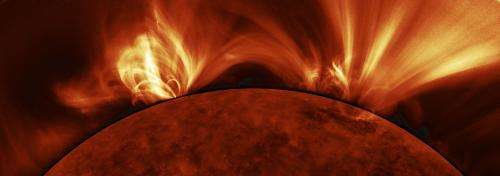Stellar winds

(PhysOrg.com) -- The Sun, glowing with a surface temperature of about 5500 degrees Celsius, warms the Earth with its salutary light. Meanwhile the Sun's hot outer layer (the corona), with its temperature of over a million degrees, ejects a wind of charged particles at a rate equivalent to about one-millionth of the moon's mass each year. Some particles bombard the Earth, producing radio static, auroral glows, and (in extreme cases) disrupted global communications. Astronomers can only partially explain two longstanding, related questions: how is the corona heated to temperatures so much hotter than the surface? And how does the corona produce the wind? The answers to both involve turbulence in the Sun's atmosphere, and magnetic fields.
The Sun is not unique. All stars, including those more massive than the Sun and those less massive, are believed to have stellar winds at some level. Stellar mass loss has a significant impact on the evolution of the stars, on any surrounding planetary systems (they are bombarded by the particles), and on the evolution of gas and dust in galaxies. The Sun’s mass loss, for example, was probably an important factor in the early erosion of atmospheres from the inner planets of the young solar system. Unfortunately, the winds of other stars are even more poorly understood than the Sun's, to the extent that astronomers cannot even predict a star's mass loss rate.
CfA astronomers Steven Cranmer and Steven Saar have specialized in the study of stellar winds for many years. In a new paper forthcoming in the Astrophysical Journal, they present a new, self-consistent model of stellar winds that succeeds for the first time in reproducing a wide range of observations. Based on an extension of models of the Sun's wind, the new theory can now be incorporated into a wide range of other research on stars to understand more accurately and precisely how stars evolve, and how they influence their environments.
Provided by Harvard-Smithsonian Center for Astrophysics

















